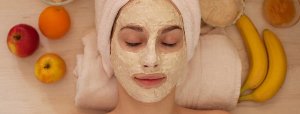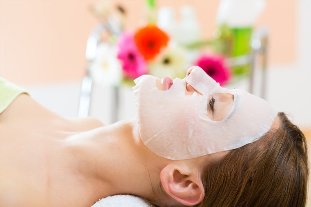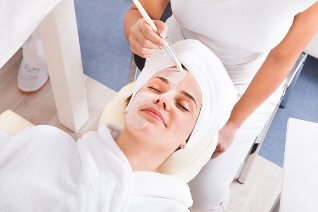
The cosmetics industry is developing tons of masks that offer it for both professional salons and home use. However, homemade face masks made from natural materials will always be preferred over factory made options.
After 25 years, girls should start looking at their faces and not only wash them off with clean water, but also feed them with various masks. Otherwise, insufficient care will manifest itself in early facial expression wrinkles and a noticeable deterioration in skin conditions.
Which face masks are there?
Usually face masks are categorized according to the effect they produce. There are mask types:
- nourishing, moisturizing, toning and cleansing - designed for the constant care and care of skin in perfect condition;
- anti-inflammatory, whitening, anti-couperose - this group of masks successfully fights against obvious skin imperfections;
- anti-aging, lifting masks - belong to the anti-aging group and help tighten the skin of the face.
How do you determine your skin type?
Before choosing a face mask you need to determine your skin type. In classical cosmetology it is customary to distinguish between skin types:
- bold,
- dry,
- normal,
- has been merged.
A homemade face mask should be chosen depending on which skin type, as the needs of different looks differ significantly.
As a rule, this is not a problem, because girls often take care of their appearance and skin type can be easily determined even by looking in the mirror. However, sometimes difficulties arise. Therefore, to accurately determine your skin type at home, wash your face with normal neutral soap and do not apply any products.
After about an hour and a half, place a well-absorbent paper towel firmly on your face. Take a close look at the napkin and assess the degree of oily skin:
- If the napkin has traces of sebum all over the surface, it means the skin is completely loose and you have oily skin type
- If there is no scar left on the napkin, but the skin is not peeling or feeling tight, your skin type is normal.
- If there are no greasy spots on the napkin but you feel significant tightness, your skin is dry type.
- If a thick scar is imprinted on your forehead, nose and chin in the middle of the napkin, and there is no scar on the skin (dry or normal) in the area where the cheeks and temples are applied, such an uneven distribution of fat indicates a combined or mixed skin type.
Home nourishing face masks

Nutritious masks are necessary to compensate for the lack of nutrients, vitamins and microelements in the skin.
Recipe # 1. Nourishing mask (honey) for oily skin
A simple composition of 2 teaspoons of honey, 20 drops of lemon juice and 1 tablespoon of low-fat sour cream is ideal for oily skin. Mix all the ingredients in a bowl until smooth, apply the resulting mixture on your face. After waiting for 20 minutes to half an hour, rinse with warm water.
Mask nourishes the skin, gives even color, shine and beauty.
Recipe # 2. Nourishing mask for dry skin
Use the following ingredients to nourish dry skin at home:
- 1 egg yolk,
- 2 teaspoons of milk
- 1 half tablespoon of fine oatmeal.
Pour the oatmeal with very warm milk, soak a little (10-15 minutes). Beat the egg yolks with a fork and mix with flakes. Apply the mass on your face and leave it for 20 minutes.
Penetrating deep into the pores, this soothing mask nourishes dry skin, removes the feeling of tightness and flaking, and gives a soft and velvety appearance.
Recipe 3. Nourishing mask for normal skin
It is a great misconception that normal facial skin does not need nutrition, care and saturation with vitamins. Grape-based nourishing mask for normal skin gently and carefully cares for and calms the skin.
Crush 6-7 grapes of any white variety (or black as a last resort), remove all seeds and skins, combine the grape mass with 1 tablespoon of sour cream. Apply the mass on the face, hold for 20-30 minutes, then rinse with warm water. The mask is so nourishing that even skin irritations can heal.
Home moisturizing masks
Natural moisturizing face masks keep your skin moist. Often, hydration is required in the summer and spring, when, under the influence of ultraviolet radiation and ambient temperature, some of the moisture disappears from the surface layers of the skin. Even mild dehydration can cause a decrease in skin elasticity, slack appearance and wrinkles.
Recipe # 4. Moisturizing masks for oily skin
The recipe below will help moisturize oily skin. Whisk 1 egg white and mix with 20 ml of liquid honey until smooth. Add 1 tablespoon of chopped oatmeal. Apply the mask on your face, let it sit for 20 minutes. First, rinse with warm water, then rinse your face with cold water. You can replace the flakes with potatoes or starch to tighten pores and nourish your skin.
Recipe # 5. Moisturizing masks for dry skin
Dryness is perfectly removed with a curd mask.
Dry skin needs hydration, especially at any time of the year, not just in the summer and spring. Mix about 30 grams of normal fat cottage cheese with 2 tablespoons of milk, heat it to body temperature. Bring the mass to a uniform consistency without lumps. Apply the resulting mask on the skin for 15 minutes. Rinse it off with lukewarm water.
Recipe # 6. Moisturizing masks for normal skin
Use a grapefruit mask to moisturize normal skin. To do this, mix the chopped meat of two grapefruit slices with 1 egg yolk. Apply the mask on the skin for 15 minutes. Then rinse with lukewarm water.
Firming and cleansing homemade face masks
Cleansing and toning masks have an overall strengthening and beneficial effect on the skin, activating subcutaneous circulation and cleansing the pores of the face from oil secretions, giving it a youthful appearance.
Recipe # 7. Toning mask for oily skin
Oily skin is toned perfectly with a white clay mask. To prepare it, dissolve 2 tablespoons of white clay in cold boiled water, add 1 egg white, 3-4 drops of lemon juice and 5 ml of honey. The resulting homogeneous mass should resemble sour cream in consistency. Apply the mask on your face and let it dry completely. Immediately after it dries completely, rinse off the clay mask with warm water.
Recipe # 8. Purifying mask for dry skin
Dry skin visibly heals and cleansed with the effect of white clay. To make a mask at home, take 1 tablespoon of white clay, 2 times more milk and 5 ml of honey. Blend until smooth and apply on face. After 10-15 minutes, rinse off the mask and finally use moisturizer after cleansing.
Recipe # 9. Toning mask for normal skin
Normal skin quickly regains its freshness and firmness with a lemon peel face mask. Mix 1 egg yolk and 20 ml of low-fat sour cream, add finely grated 1 lemon zest. Do not keep the mask on your face for more than 30 minutes.
How to whiten homemade face masks
Many girls dream of getting rid of freckles and often whitening the face. Whitening face masks at home will help lighten age spots, even age spots.
Recipe # 10. Cucumber whitening mask is known by everyone for its good effect. Finely grate a medium cucumber (no seeds) and mix with daily nourishing cream or sour cream. Apply mass to your face for 20 minutes. Rinse it off with lukewarm water.
Recipe # 11. The following whitening face mask turns out to be pretty liquid. At home, mix liquid honey and lemon juice in equal parts by volume. Soak gauze in the resulting mass, and then place it on your face. Leave it for 15 minutes, then remove the napkins and rinse your face gently with water.
Anti-aging home face masks
Over time, the skin begins to age - this is an inevitable process. However, when the first problem is wrinkles, one should not lose heart, but instead should include the rejuvenation procedure in regular skin care. Regular use of anti-aging collagen masks allows you to postpone the appearance of new age-related changes in the skin of the face and remove existing small wrinkles.
Recipe # 12. Aloe vera rejuvenating face mask is very popular at home. Mix a tablespoon of the juice of this herb with the same amount of nourishing face cream and premium vegetable oil (preferably olive oil). Stir the mask gently warm and apply, keep on face for 10 minutes.
Recipe # 13. You can make a mask from fresh banana leaves in summer. Crush the leaves and mix them with honey in equal parts. If the mixture is too thick like a gelatinous mixture, dilute it slightly with water. Keep this oatmeal on your face for at least 15 minutes. First remove with a damp swab, then rinse your face with cold water. And there is no need for botulinum toxin.
Masks with lifting effect for the face at home
The fight against sagging requires constant attention from women over 30. Therefore, when the skin begins to fade, you need to arm yourself with time-tested tools that will help align the upper layer of the epidermis.
Recipe # 14. This vitamin anti-aging face mask is prepared from home pharmacy ingredients.
Contents:
- 1 tablespoon pink clay
- 1 ampoule of vitamin A
- 30 ml of unflavored green tea is brewed.

Lightly dilute the dry clay with tea and bring the mass to a homogeneous texture, stirring constantly. Add vitamin A and apply the entire mixture on the skin. The mask lasts 25 minutes. Regular use of this recipe gives firmness and health to the skin.
Rinse this mask off with plenty of cold water.
Recipe # 15. A natural and effective removal can be observed in the egg whites. Roll a protein into a firm foam and mix it with two teaspoons of soaked oatmeal. The exposure time of the mask to the skin is 15 minutes.
According to the girls it has a lifting effect: there is skin tightening.
How to apply a face mask at home correctly
Before applying any mask, you should clean your face from decorative cosmetics with a gentle make-up remover. A refreshing gel will usually complement the makeup removal procedure, but you can also use an additional scrub.
It is desirable to exfoliate the dead cells beforehand so that all the ingredients that make up the mask penetrate the facial skin well, this will provide the greatest effectiveness. The scrub can also be used at home according to any coffee scrub recipe, for example.
When applying masks, follow the general guidelines for home cosmetic formulations:
- Mask application procedure cannot be done "while running". Set aside all the household chores and just spend half an hour on yourself.
- Any effective homemade face mask should be prepared (mixed) just before use. The remaining mass cannot be stored.
- All components of the mask should be taken in good quality and sour cream, fruits, kefir, etc. ingredients must be fresh.
- Before applying the mask, the face should be cleaned as usual. Owners of oily and combination skin will also likely need a pre-exfoliating peel. After cleansing the skin, open the pores as much as possible, it can be steamed over the bath or a warm wet compress can be used. This will allow all ingredients to be absorbed as much as possible and have the best effect.
- To keep the hair away from around the face, tie it into a bun and secure it with something.
- Depending on the consistency of the mask, it should be applied with clean hands, brush, gauze or cotton pad.
- Most masks should be applied not only to the face, but also to the neck and décolleté area. Drying masks for oily skin would be an exception, as the skin in the décolleté area is much drier.
- Apply the homemade mask along the massage lines, making movements from the middle of the face to the temples. An exception is the skin directly around the eyes; You do not need to apply a mask on it.
- Rinse the mask with clean water. It is better not to take it from the tap, but to prepare a jug of boiled water that has been pre-cooled to body temperature.
- You do not need to wipe your face after rinsing off the mask, pat the excess moisture gently with a clean towel. Apply a cream suitable for your skin type on a moist face.
- Do not expect an immediate effect from the first procedure. Homemade face masks should be repeated regularly at intervals of 1-3 times a week. Course duration should be at least 3 weeks.
Precautions When Using Home Masks
Before applying the mask prepared for allergy-prone girls at home, it is mandatory to do a test on the wrist or inner elbow. If signs of an allergic reaction are seen, take an antihistamine and do not use this product.















































































